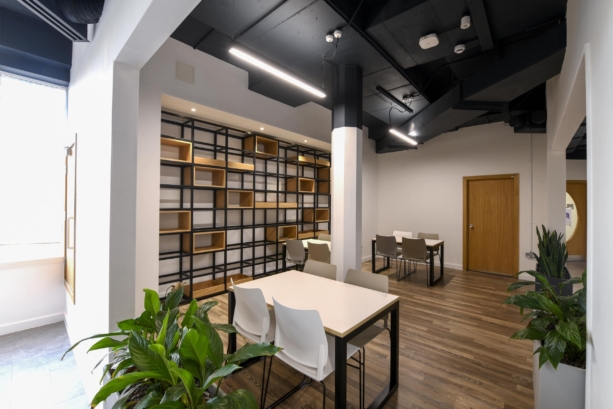
We are a leading manufacturer of quality internal and external lighting products for commercial, industrial and retail applications.
View all productsAt Ansell Lighting we design and manufacture an extensive range of luminaires for a diverse number of sectors and applications. Whatever the shape, purpose or style of your space, we have a lighting solution.
View all sectors & applicationsWe are a leading manufacturer of quality internal and external lighting products for commercial, industrial and retail applications.
Welcome to Ansell lightingWe are here to answer any questions you may have, help you find a stockist or speak to a local member of our team.
OCTO delivers the complete smart lighting package to transform the efficiency and ambience of commercial and residential spaces.
Find information regarding our product warranty, product data downloads and FAQs regarding lighting and technical terms. Here you will find support with training CPDs as well as useful lighting design and LED strip calculators.
Unified Glare Ratings explained

Lighting has become an extremely important necessity in our continuous 24 hour a day environment. Whilst the technological development of artificial lighting has moved ever forward since the inception of the incandescent lamp way back in the 1800’s, it has become clear that artificial light has created a number of issues in respect of light pollution and glare.
If we consider only the aspects of glare and leave light pollution for another time, then it is important that some clarification on the definition of glare is initially provided. Glare is the visual sensation caused by an excessive and uncontrolled brightness of light within the individual’s field of view.
Expanding on this statement, glare is produced when the eye is exposed to an intensely excessive and uncontrolled brightness, within the visual field, which is more than the eye can accept. Glare is subjective and the sensitivity to glare can differ greatly between individuals which as previously stated, is caused when the eye is exposed to a more intense light than it is normally adapted to. This can be natural light, such as by sunlight or artificial light, such as from the headlamp of a car or from a floodlight. It can be distracting or simply uncomfortable or can be more serious in being disabling or dangerous. Glare can prevent an individual distinguishing objects and detail. It is known that the eyes of older people are considered as being more sensitive to glare, a condition which is caused by the aging characteristics of the eye.
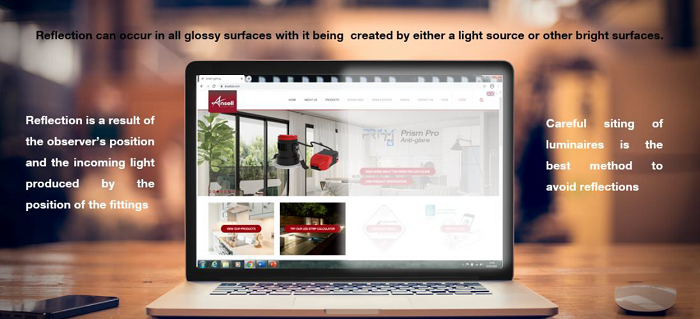
There are two forms of glare, Disability Glare and Discomfort Glare
Disability Glare – defined as directly impairing vision
Disability glare generally occurs when an object within the field of view has an excessive brightness, which is more than the eye can deal with. It is usually encountered externally, such as from oncoming vehicle coming over the brow of a hill, however internally this could be from the sun entering the space through a window or from the direct brightness produced by a light source within the space. It arises from stray light falling on the retina, usually from scatter by the media of the eye. Scattered light falls as a patch of veiling illuminance on the fovea and reduces the contrast of the retinal image, and as a result it impairs visibility and visual performance.
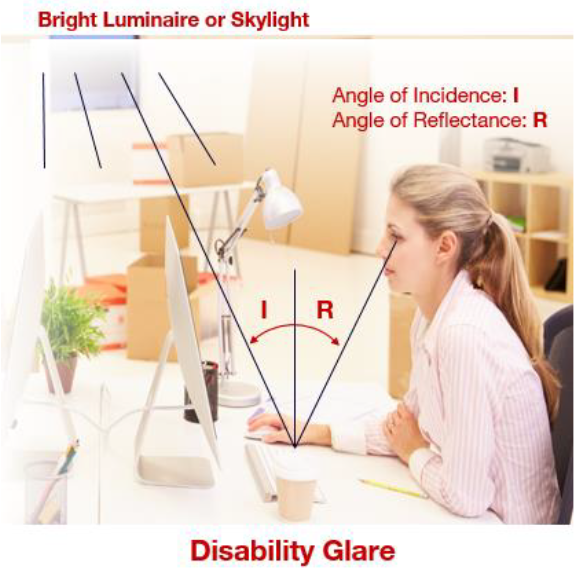
Discomfort Glare – defined as perceived discomfort
Discomfort glare is the discomfort, annoyance or in extreme cases, the pain caused by an excessively bright light source whose luminance is greater than the eye can adapt to. The degree of discomfort depends on several factors such as dimensions and luminance of the source of the glare. Discomfort glare may be different for each individual and will also depend upon the geographical position of the source to that of the line of sight of the individual as well as the contrast between the source and the area surrounding the source.
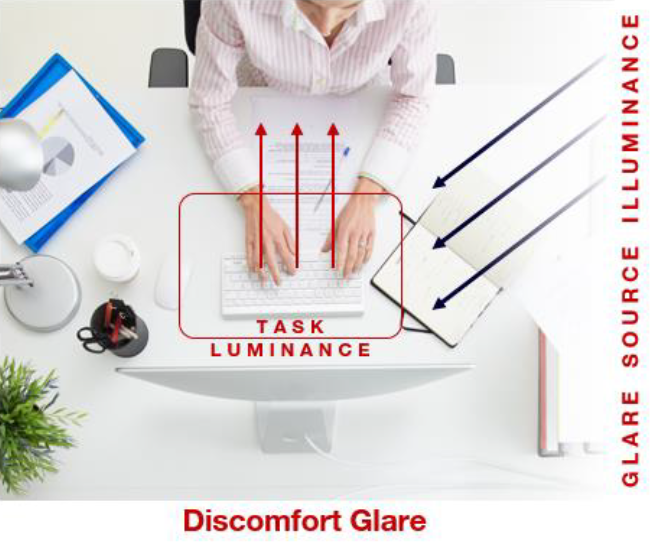
Both disability glare and discomfort glare can be caused by two directional types of glare, that being Direct Glare and Indirect Glare (Reflected Glare). Direct glare is caused as a result of high levels of brightness from a light source, which is directly within the field of vision, entering the eye and indirect glare is caused by reflected brightness, which is where the direct light from the source is reflected off a bright surface before entering the eye.
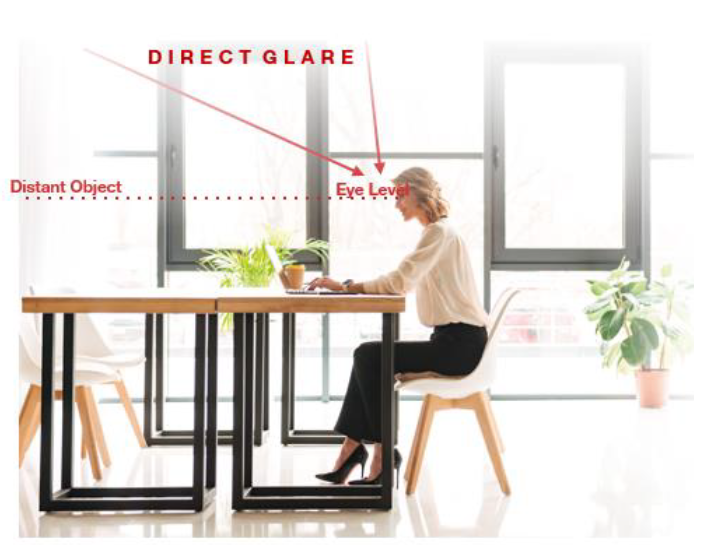

In lighting the term Glare is determined and classified by the abbreviation ‘UGR’ which stands for ‘Unified Glare Rating’ and is the method of calculating glare from luminaires, light through windows and that of bright light sources. The UGR rating helps to determine how likely a artificial light source is to cause discomfort to those individuals around it. The UGR value is a dimensionless parameter which provides information about the degree of psychological glare of a lighting installation in an indoor space.
Glare is a common problem within interior workplaces, which can be caused by inappropriate luminaires giving excessive brightness either directly into the line of sight of individuals or can be as a result of being ‘bounced off’ reflective surfaces, such as computer screens, whiteboards, etc. This can cause significant disruption for the occupants of interior workspaces such as in offices, in terms of individuals experiencing headaches & eye trouble, which can then lead to employee absences and resulting in a negative financial effect to the business.
The degree of Discomfort Glare for indoor lighting is calculated by using an equation which takes into account a number of factors that may contribute to glare caused by a luminaire, such as the angle of the luminaire, the likelihood of glare and the luminance value according to the UGR (Unified Glare Rating) method. The calculation process is done in accordance with the CIE document – CIE 117.
One UGR unit represents the least detectable step in discomfort glare evaluation, and three UGR units represent an acceptability step in glare criteria. The UGR limits range from 5 to 40 and the lower the number, the less glare will be an issue, where a low UGR of 10 means the glare will go unnoticed, while a UGR of 30 will cause much distraction. The values of glare and their meaning are defined as:
≤ 10 Imperceptible
≤ 13 Just perceptible
≤ 16 Perceptible
≤ 19 Just acceptable
≤ 22 Unacceptable
≤ 25 Just uncomfortable
≤ 28 Uncomfortable
Within commercial offices, for the installation to be classified as “low glare” it must achieve a UGR (Unified Glare Rating) of equal to or below a value of 19 when measured at the eye height of the individuals working within the office, that is normally assumed as being 1.2 metres above finished floor level (FFL). Any calculated value above 19 may cause discomfort, which further enforces the need for a high-quality interior lighting design capable of achieving an acceptable UGR rating of <19. There are several different UGR limits associated with different applications and these should not be exceeded in the appropriate environment. A list of these limits for some sample areas include:
≤ 13 The glare is usually un-noticed
≤ 16 Technical Drawing
≤ 19 Reading, Writing, Training, Meetings, Computer-based work
≤ 22 Craft and Light Industries
≤ 25 Heavy Industry
≤ 28 Railway Platforms, Foyers
A greater summary of the maximum UGR limits for a wider range of interior applications is given within the British Standard document – BS EN 12464-1:2011.
In concluding, the lighting design team at Ansell Lighting create lighting solutions, (wherever possible and within the confines of the application,) to deliver an installation which achieves the required UGR value, based upon the information specified at the time of the design request. If when the lighting is installed, there were variances within the designed space such a change of internal dimensions, reflectances, the layout of the desk furniture or in the location and orientation of the specified luminaires, this could result in a different UGR being experienced by the room occupants from that which was initially designed. This does not mean in any way that the calculation of UGR should not be undertaken, rather it would still be considered as good practice to select fittings whose light distribution tended to reduce the value of UGR.
You Might Also Be Interested In...

